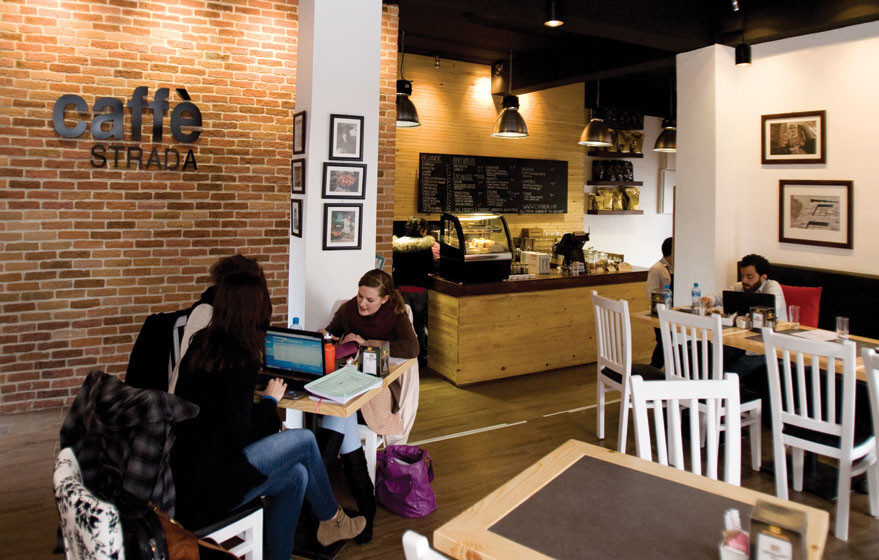[O]ver the few months after Caffè Strada opened in 2012, several friends began rhapsodizing to me about this amazing new café they’d discovered and just had to tell me about. I couldn’t bear to brag that I was way ahead of them on this discovery because their enthusiasm so closely matched the rush and joy I’d felt when I found Strada. When you uncover something you love—a good cup of coffee—in a place you don’t expect it—Amman, Jordan—you deserve praise for your treasure hunting. In Amman, an Arab city brimming with great Turkish coffee, espresso and drip coffee were rated not for their quality but for their tolerability. Then along came Caffè Strada. Each of these conversations ended with a line like, “It’s not just good-for-Amman coffee; it’s good coffee.”
It’s not much of a stretch to say that the Iraq War brought Western-style coffee to Jordan. Before the conflict, outside of luxury hotels and a couple hip restaurants, the only sludge-less coffee option was Nescafé. Then in 2005, when the insurgency kicked off hard, the rich neighborhoods of Amman filled with American and European diplomats, contractors, and corporate workers who did business in Iraq but couldn’t safely live in Baghdad. That year, Jordan’s first Starbucks opened in the capital’s embassy district on a main thoroughfare that would clog with coffee traffic every morning and evening for months. When I returned five years later, Starbucks, Gloria Jean’s, Caribou Coffee, and Second Cup had staked out the country, drawing locals and expats alike.
As the global companies merrily colonized Jordan, local cafés began to appear. A few tried to split the aesthetic difference between the boisterous, smoke- and backgammon-filled local coffeehouses and the second-wave chic of Western chains, creating unlovable cultural stepchildren. But in developing countries, commercial and cultural changes can happen fast, especially when a model, if not a franchise, can be imported and plunked down fully formed.

The two friends, with former owner Nick Neibauer, a Seattleite who met and married a Jordanian girl while living in Italy, opened Caffè Strada in 2012 along Rainbow Street, a popular and rare pedestrian-friendly stretch in a charming 1920s neighborhood. On Rainbow Street, as with the rest of Amman, every building is made of the same desert dust-coated white stone, and most interiors are the reverse side of those stones paired with white tile. Nearly every café and restaurant fills these spaces with overstuffed furniture, faux-historical decorations, football banners, and TVs. Strada’s storefront in a mid-century rough-hewn apartment building sets the café’s aesthetic tone with a black metal doorframe inset with dust-free glass. The interior feels like a meeting of Milan and Portland, with clean lines and wood, exposed brick, and white-painted surfaces set against black borders. The uncluttered decorations and, especially, the uncommon wood create a sanctuary and hint at how serious Laith and Firas take coffee and tea.
Jordan’s few roasters work with low-grade beans and don’t shoot for espresso, so Strada imports Attibassi from Bologna and the preparation and presentation are classic Italian. In a town fairly new to espresso, Strada introduced Ammanis to the terms doppio, ristretto, and lungo. Suddenly, lattes and cappuccinos were voluminous drinks with delicate foam rather than just warmed up milk. When the rosettas and hearts showed up, even though they wouldn’t pass muster in the States, people just stared in delighted perplexity. The tea service, overseen by Laith, was even more groundbreaking for a country accustomed to CTC bags steeped with mint or sage. Importing Jing tea from England, the glass pots came on slotted bamboo servers with the leaves, which had been steeped behind the bar, displayed on the board to visual and aromatic success.

Laith says he’s interested in Strada taking up roasting, but for Strada to push into that realm of coffee would require major improvements in Jordan’s economic fortunes and bureaucratic policies. Those are two intractable problems in a small country full of them.
When I would leave the café, walking out into the thrum of the city, that’s when Strada’s remarkableness would hit hardest. In an impoverished country whose past decade has been defined by waves of refugees from neighboring conflicts, the existence of Caffè Strada is unlikely. That the coffee and tea are so damn good is incredible.
—Cory Eldridge is the editor of Fresh Cup.

















